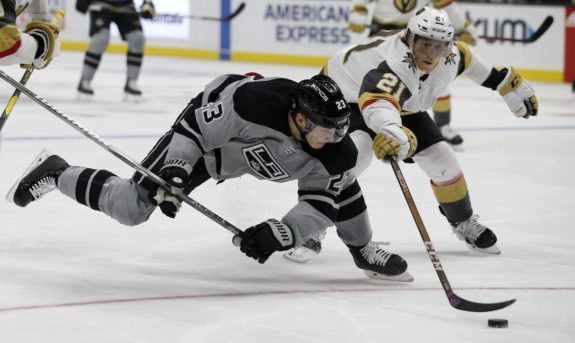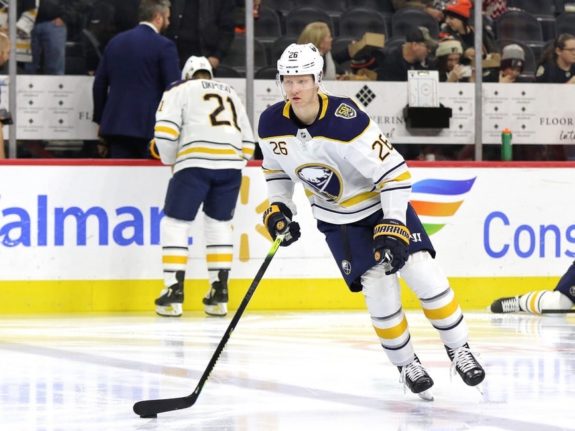In his introductory offseason with the Buffalo Sabres, general manager Kevyn Adams has done well in putting together a competitive 2020-21 roster. Financially, the team allocated currency into reasonable contracts, while addressing roster needs with acquisitions that are on relatively harmless short-term deals.
With most of the Sabres’ primary decisions for the upcoming season finalized, the team will only know if their investments were worthwhile when the pucks drop eventually. While we’re nearing the end of an exceptional offseason to say the least, here’s an early look at the critical decisions Adams’ will face in his second year under the helm.
Sabres Future Depends on Next Season
Put simply, Adams’ future priorities will fluctuate depending on the outcome of the imminent season. In theory, the roster has evidently progressed from last season with the additions of established players with notable pedigrees. In practice however, history has shown that it takes more than a random assortment of talent to win championships.
The less-heralded acquisitions of Tobias Rieder and Cody Eakin were meant to address a glaring problem from last season; the Sabres’ historically underwhelming ability to kill power-plays. A paltry penalty-killing percentage of 75.6 percent may have been the only notion keeping Buffalo from breaking their infamous playoff drought.

Whether the issue was systemic or due to a lack of qualified personnel, Rieder and Eakin are prideful and proven penalty-killers that should uplift last season’s defensive unit.
Eric Staal will bring wisdom and discipline to a young aspiring core regardless of his individual statistics. In addition, the nature of his expiring contract means the veteran acquired from the Minnesota Wild in September will enter unrestricted free agency following next season, which puts Adams’ in an interesting yet rather simple situation.
In the event of an unprecedented fruitful season, the Sabres can make a decent attempt at convincing Staal to stay in town. If age influences his performance or the team chemistry never develops as intended, the Sabres can move on from the 36-year-old with no strings attached and place their bets on one of Dylan Cozens, Arttu Ruotsalainen, or Casey Mittelstadt making the leap to second-line center.
Dahlin and Hall Contracts
Much like the many ifs that pertain to this outlook, the decision to re-sign Taylor Hall will largely hinge on the team’s performance in a clear win-now season.
From the Sabres perspective, obtaining substantial talent to the likes of Hall is hard, and any opportunity to extend the relationship merely makes sense barring an enormous drop-off in production which likely won’t occur while playing alongside Jack Eichel.
On the other hand, there is a looming transaction that won’t be influenced by recency. The Sabres will be looking to lock down Rasmus Dahlin for the long run as he enters restricted free agency in 2021-22. While a qualifying offer worth $925,000 will be on the table, the promising franchise defenseman whom the team hopes the hand the keys to their future will certainly come to terms on a pay raise with management.

Adams’ pivotal priority is to satisfy the franchise cornerstones. Eichel is contractually locked up and the front office has proven its devotion to the generational center by constructing a competent roster around him. Signing Dahlin is the next essential step towards cementing the Sabres’ longevity and future success.
Free Agent Goalie, Reinhart and Jokiharju Contracts
The Sabres avoided arbitration by signing Sam Reinhart to a one-year contract worth $5.2 million earlier this offseason. Next summer, Adams’ will have to decide whether the Sabres want to extend his tenure with the team long-term and potentially congest future finances in the process or bring Reinhart back for one additional year before the 25-year-old hits unrestricted free agency following the 2021-22 season.

An important prospect that Adams will also need to consider alongside negotiations with the right-winger is Henri Jokiharju, who will also demand a pay raise if the Sabres aspire to keep the 21-year-old right defenseman on the roster.
Sabres fans have reason to be concerned at the prospect of another season of goaltenders Linus Ullmark and Carter Hutton, who have left much to be desired thus far in their two years running the show. Ultimately, Buffalo has its starting netminder rotation and whether the tandem can collectively step up will remain to be seen.
However, both goaltenders are set to hit unrestricted free agency in 2021-22, giving the Sabres liberty and options to upgrade the position. Ukko-Pekka Luukkonen could be serviceable at an NHL level by next season but the team’s No. 1 netminder will likely come by way of free agency.
Whether it’s the familiar Ullmark on a justifiable deal or another choice in a market featuring Jordan Binnington, Tuukka Rask, and Frederik Andersen will depend on how Adams’ decides to allocate the Sabres’ resources between the skaters.
Sabres Salary Cap Implications
The objective of any front-office is to create a stable foundation that translates to sustained success. Apart from perennial superstars that tend to stay grounded with a single team, competent franchises remain competitive yearly by navigating the turbulent salary cap waters with a calculated aggression.
Fortunately, the Sabres have time before their cap space is largely engulfed by their foundational players. Despite the increasingly likely future flat cap that will result from the global pandemic, the Sabres will have the money to spend if they so choose.
Some decisions are set in stone; the Dahlin circumstance will not be a matter of if the Sabres choose to sign him, it will be a matter of how much the team will spend on the Swedish star.
Other transactions will need to be constantly re-evaluated throughout the season. Does management invest in expensive veterans that will boost the team’s short-term championship window, or does Adams tread carefully with a flat salary cap and invest in the future by setting his sights on younger and subsequently cheaper alternatives?
The impending front-office decisions will not only make or break whether the Sabres can overcome the playoff hump but will also influence the team’s ability to become recurring Stanley Cup contenders.